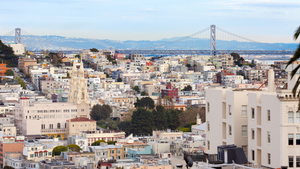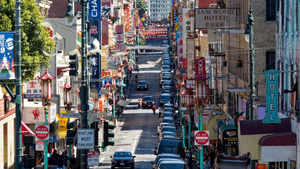
Coit Tower
Coit Tower, a 210-foot Art Deco landmark atop Telegraph Hill in San Francisco, offers visitors panoramic views of the city and bay while showcasing Depression-era murals that depict California life in the 1930s. As reported by San Francisco Recreation and Parks, this iconic structure, completed in 1933, features an observation deck accessible by elevator, providing 360-degree vistas of the Golden Gate and Bay bridges.
Lillie Hitchcock Coit: The Woman Behind the Tower
Lillie Hitchcock Coit (1843-1929) was a colorful San Francisco socialite and patron of the city's volunteer firefighters. Known as "Firebelle Lil," she developed a fascination with firefighting at a young age and was made an honorary member of Knickerbocker Engine Company No. 5 in 1863. Coit was known for her eccentric behavior, including smoking cigars and wearing trousers long before it was socially acceptable for women to do so. Upon her death, she bequeathed one-third of her estate to San Francisco "to be expended in an appropriate manner for the purpose of adding to the beauty of the city which I have always loved". This bequest led to the construction of Coit Tower on Telegraph Hill, designed by architect Arthur Brown Jr., as well as a statue of three firefighters in Washington Square Park. Despite popular belief, the tower was not intentionally designed to resemble a fire hose nozzle, though it stands as a fitting tribute to Coit's lifelong support of San Francisco's firefighters.
The Murals of Coit Tower: Art in the Great Depression
The murals of Coit Tower, created in 1934 as part of the Public Works of Art Project, represent a significant collection of Depression-era art in the United States. Twenty-five artists, including four women and twenty-one men, were commissioned to paint 27 murals depicting California life during the Great Depression. These frescoes, covering over 3,600 square feet of interior wall space, explore themes such as agriculture, industry, city life, and social issues of the time. Inspired by Mexican muralist Diego Rivera, several artists incorporated left-wing political messages into their work, leading to controversy and a brief closure of the tower before its public opening. Despite initial criticism, the Coit Tower murals have endured as a cherished artistic treasure, offering visitors a vivid glimpse into 1930s California through the lens of Social Realist art.
Architectural Design and Construction of Coit Tower
Coit Tower, designed by architects Arthur Brown Jr. and Henry Temple Howard, was constructed between 1932 and 1933 in the Art Deco style. The 210-foot structure is built of unpainted reinforced concrete, reflecting a stripped-down classicism characteristic of Brown's later works. The tower's design was the result of a competition initiated after Lillie Hitchcock Coit's bequest to beautify San Francisco. Brown, who had previously designed other San Francisco landmarks such as City Hall, created a simple yet elegant form that has become an iconic part of the city's skyline. A concrete relief of a phoenix by sculptor Robert Boardman Howard adorns the main entrance, commissioned by the architect and cast as part of the building. Despite popular belief, the tower's resemblance to a fire hose nozzle is coincidental and not intentional.
Themes of the Murals
The murals of Coit Tower offer a rich tapestry of themes that reflect the social, economic, and cultural landscape of California during the Great Depression. These artworks, created under the Public Works Art Project, depict various aspects of life in 1930s California, focusing on labor, industry, agriculture, and urban scenes.
One of the prominent themes is labor and industry. Many murals showcase workers engaged in various occupations, from factory workers to farmers, highlighting the importance of the working class during this challenging period. For instance, Ralph Stackpole's mural depicts industrial scenes, emphasizing the role of labor in California's economy.
Agriculture features heavily in the murals, reflecting its significance to California's economy and identity. Scenes of fruit picking, farming, and rural life are common, illustrating the state's agricultural heritage and the challenges faced by farmers during the Depression.
Urban life and modernization are also key themes. The murals capture scenes of city streets, public spaces, and technological advancements of the time. For example, one mural on the second floor depicts a street scene along Powell Street, showing people carrying suitcases, walking dogs, and riding cable cars - elements that remain familiar in San Francisco today.
Social issues and class distinctions are subtly portrayed in the murals. The artworks progress from depicting working-class scenes on the first floor to more leisurely, affluent activities on the second floor. This transition reflects the social stratification of the era, with murals showing hunting, picnicking, and relaxing by creeks on the upper level.
Politics and social idealism are woven throughout the murals, sometimes controversially. Some artists incorporated left-wing political messages, reflecting the social tensions of the time. One notable example is a mural depicting a man pulling a copy of "Das Kapital" from a library shelf, which became a popular spot for tourist photographs.
The murals also touch on themes of education, immigration, and California's natural beauty. They provide a comprehensive view of life in California during the 1930s, from bustling cityscapes to serene rural scenes.
It's worth noting that while the murals aim to represent California life, they have been criticized for their skewed representation of ethnicity. The absence of Chinese Americans and Latin Americans in the murals has been pointed out as a form of historical revisionism.
Overall, the Coit Tower murals serve as a visual time capsule, capturing the spirit, challenges, and aspirations of Depression-era California through a diverse range of themes and subjects.
Artists of the Coit Tower Murals
The Coit Tower murals were created by a diverse group of 25 artists, including 4 women and 21 men, who worked collaboratively under the Public Works of Art Project in 1934. These artists, many of whom were students of the renowned Mexican muralist Diego Rivera, employed fresco techniques to paint directly onto the wet plaster walls of the tower.
Among the notable artists were Victor Arnautoff, who supervised the project, and Ralph Stackpole, whose mural "Industries of California" depicts workers engaged in packing, canning, and metal casting. Bernard Zakheim's "Library" mural became one of the most recognizable and controversial pieces, featuring people reading books by authors such as Hitler, Kenneth Rexroth, and Oscar Wilde.
Other significant contributors included:
Maxine Albro
Ray Boynton, who painted "Animal Force and Machine Force"
John Langley Howard, creator of "California Industrial Scenes"
William Hesthal, who depicted "Railroad and Shipping"
Suzanne Scheuer, one of the few female artists, who painted "Newsgathering"
Mallette Dean, responsible for "Stockbroker" and "Scientist"
George Harris, who created "Banking and Law"
These artists earned an average of $31.22 per week and completed the project in six months. Their diverse backgrounds and styles contributed to the rich tapestry of themes and perspectives represented in the murals.
The artists faced challenges during the creation process, including political tensions surrounding the 1934 Maritime Strike. Some murals were criticized for allegedly depicting Communist symbols, leading to controversy before the tower's public opening. Despite these obstacles, the artists successfully completed a unified body of work that adhered to a consistent earth-toned palette and scale, as insisted upon by the San Francisco Arts Commission.
The Coit Tower murals project not only provided employment for artists during the Great Depression but also resulted in the largest collection of Depression-era art in the United States. Today, these murals stand as a testament to the artists' skill and vision, offering visitors a vivid glimpse into 1930s California through the lens of Social Realist art.
Lillie Coit's Philanthropy
Lillie Hitchcock Coit's philanthropy extended far beyond her famous bequest to the city of San Francisco. Throughout her life, she demonstrated a deep commitment to supporting firefighters and enhancing her beloved city.
Coit's most significant philanthropic act was leaving one-third of her estate, approximately $225,000, to the city of San Francisco upon her death in 1929. This generous bequest came with the stipulation that it should be used "to be expended in an appropriate manner for the purpose of adding to the beauty of the city which I have always loved". The city ultimately used this donation to construct the iconic Coit Tower on Telegraph Hill, which stands as a lasting tribute to her generosity and love for San Francisco.
However, Coit's philanthropy was not limited to this final bequest. Throughout her life, she was a dedicated patron of San Francisco's volunteer firefighters. Her support for firefighters began at a young age and continued throughout her life. She frequently visited firefighters when they were ill and sent floral tributes when they passed away. This ongoing support earned her the affectionate nickname "Firebelle Lil" and made her a beloved figure among the city's firefighters.
Coit's philanthropic spirit extended beyond her local community. During her extensive travels in Europe and the Orient, she collected numerous gifts from royalty and nobility. Many of these items, including rare gems and priceless objects of art, were later donated to museums in San Francisco, enriching the city's cultural heritage.
In addition to the Coit Tower, her bequest also funded another significant landmark in San Francisco. A statue of three firefighters was commissioned and placed at the northwest corner of Washington Square Park, further commemorating her lifelong support of firefighters.
It's worth noting that Coit's philanthropy was not just financial. She dedicated much of her time and energy to causes she believed in. As a member of the Daughters of the American Revolution (DAR), she likely participated in the organization's various charitable and patriotic activities.
Lillie Coit's philanthropic legacy continues to impact San Francisco today. The Coit Tower and the firefighter statue stand as enduring symbols of her generosity, while her lifelong support of firefighters helped strengthen this vital service in the city. Her example of using personal wealth for public benefit has inspired generations of San Franciscans and visitors alike.
Related Posts

Fisherman Wharf San Francisco
Fisherman's Wharf, one of San Francisco's most iconic and popular tourist destinations, offers a vibrant mix of family-friendly attractions, fresh seafood restaurants, unique shops, and stunning bay views.

North Beach Little Italy
North Beach, also affectionately known as "Little Italy," offers a delightful blend of history, culture, and culinary adventures.

Chinatown
San Francisco Chinatown is a vibrant and culturally rich neighborhood that offers visitors a unique blend of history, tradition, and modern attractions.